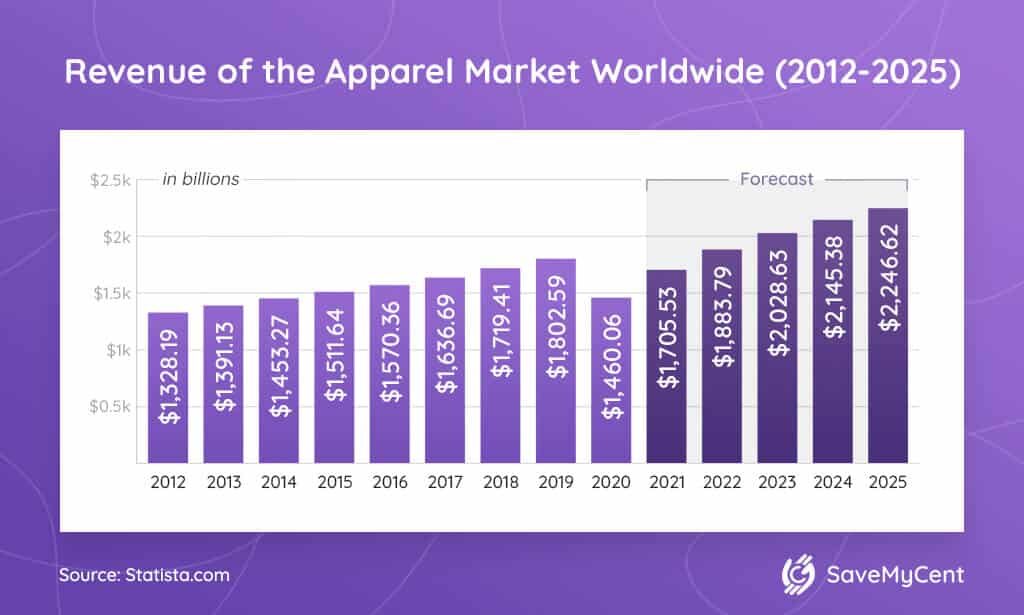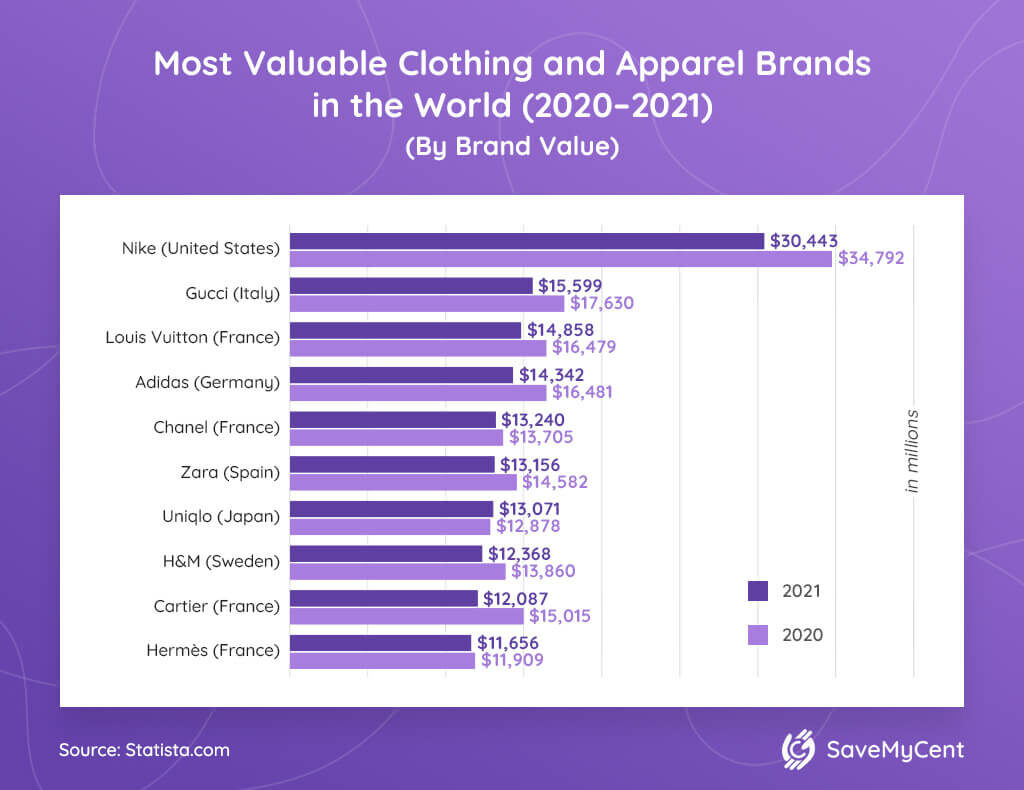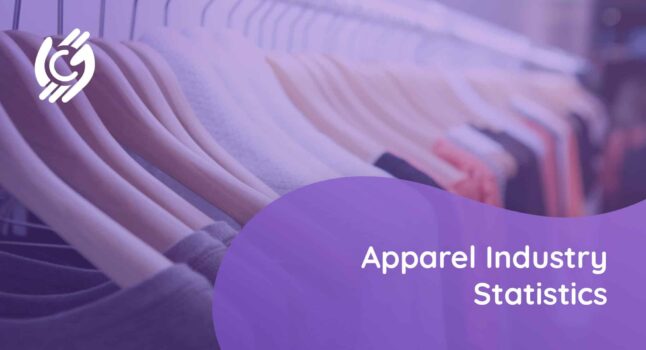The clothing industry changed last year.
Or in fact, the consumers have changed. With the global climate crisis and the pandemic, many people are changing their approach to clothes. The differences in the approach can be seen at a large scale, sorted by age, gender, financial background, jobs, and interests.
Here’s how it all reflected on the apparel industry:
Apparel industry statistics confirm that the clothing industry suffered a significant loss in 2020. However, the industry is a key employer, and it’s becoming more and more essential for workers, economies, investments, and profits around the globe.
Now more than ever, many apparel brands are working towards making fashion appear more ethical. They’re trying to reduce their negative impact on nature and climate by becoming mindful and finding solutions to eliminate waste.
So let’s see what the stats have to say about the state of the industry.
Trendy Clothing Industry Statistics (Editor’s Choice)
- The US apparel market size will fall to $317,56 billion in 2021.
- Nike is the most valuable apparel brand in the world in 2021.
- In 2020, apparel and accessories represented 36.7% of all US ecommerce sales.
- The second-hand market is expected to outgrow the fast fashion market by 2029.
- Global apparel industry statistics suggest the worldwide clothing industry market will rise to $2.25 trillion by 2025.
- The US, Japan, Brazil, Italy, and China are some of the biggest apparel markets.
- Between 2000 and 2014, shoppers bought 60% more garments than 15 years ago.
- American women spend up to $496 monthly on clothes, according to clothing industry trends.
Apparel Industry Revenue Stats
1. The global apparel market size is projected to grow to $2.25 trillion by 2025.

Estimations show a decent growth from $1.5 trillion in 2020, revealing that demand for shoes and clothing will rise. These stats confirm that the apparel market is one of the most powerful ones out there. Also, 75 million workers make sure to keep the industry’s wheels turning.
2. The US apparel market size will fall to $317,56 billion in 2021.
(Statista)
That is a significant decrease from 2019, when the market size was estimated at around $368 billion. The drop was not unexpected, but the industry still has to rethink its strategy for 2021, relying mostly on ecommerce.
3. 50% of the global clothing demand consists of womenswear.
(Statista)
Children’s clothing, accessories, and menswear come next in the global market. In the US, $41 billion came from womenswear, compared to a “mere” $8.8 billion from menswear.
4. Retail clothing industry statistics show that the clothing revenue per person in 2021 will amount to $951.03 in the US.
(Statista)
As usual, women’s apparel will generate most of the sales, with an estimated market volume of $165.37 billion in 2021.
5. In 2020, apparel and accessories represented 36.7% of all US ecommerce sales.
(eMarketer)
Statistics show the increasing number of Americans who resort to shopping from the comfort and safety of their homes. Online apparel sales are expected to reach a whopping $100 billion by 2021, according to online apparel sales statistics. Amazon, Gap, and Nordstrom are the biggest ecommerce chains.
6. In 2020, there were about 86,000 workers in the US apparel industry.
(Dr. Sheng Lu)
In contrast, that number was 902,740 in 1990, apparel industry employment statistics reveal. The industry has been outsourcing jobs to cheaper labor markets such as Mexico, China, and Southeast Asia for three decades now. Combine that with increasing automation and the figure becomes even clearer.
7. The fast fashion industry declined by 12.32% from $35.8 billion in 2019 to $31.4 billion in 2020 .
(McKinsey)
So, the fashion industry growth rate will determine the trends for 2021, although the industry won’t recover by at least 2022.
8. In 2019, the US baby and young children’s apparel market was worth $27 billion.
(Statista)
This stat shows that Americans spend tremendous amounts of money to dress their children, and these habits haven’t changed in 2022 either. Baby clothing industry statistics show that the times of inheriting your older sibling’s clothes are long gone.
9. Luxurious brands make 97% of the profits in the fashion industry.
(McKinsey)
According to this clothing industry statistic, 20 luxurious brands make virtually all profits in the industry! Some of them are Nike, LVMH, Inditex, and ETC. These fashion titans have doubled their profits over the last ten years. In 2017, they generated a mind-blowing $2 billion each.
10. To resolve its problem with decreasing sales, Gap turned to its old label Old Navy to limit its sales fall by 1% instead of the predicted 3,58%.
(The Business of Fashion)
Gap has been experiencing a decrease in sales in the US. To revamp its brand name and soften the financial blow, Gap decided to promote its Old Navy brand, which offers inexpensive clothing for the whole family.
Additionally, they began collaborating with the clothing retail platform thredUp to come up with eco-friendly solutions for the environment. United States apparel industry statistics confirm that this move made Gap appealing to Millennials.
11. The GDP of nearly 130 poverty-stricken countries is equal to the amount of money US buyers spend on shoes, clothes, and jewelry.
(Common Objective)
This stat shows disturbing research results. The amount of money Americans spent on shoes, accessories, and clothing garments came to be equal to poor countries’ GDP, or just a bit larger than the size of the Italian economy.
12. 80% of online buyers ordered physical goods, such as clothes, food, and electronics.
(Common Objective)
A recent clothing industry analysis revealed that eight out of ten consumers bought physical goods online. What’s more, 34% of online buyers purchased accommodation, holiday tickets, etc.
Additionally, 25% bought downloadable content or apps. Lastly, 16% of e-consumers ordered e-tickets for different events like concerts and football games or subscribed to different telecommunication services.
Apparel Industry Statistics and Clothing Brands
13. Nike, Levi’s, Old Navy, and Victoria’s Secret are among the ten most popular brands in the world.
(Common Objective)
Adidas, Levi’s, H&M, VS, Nike, Uniqlo, C&A, Ralph Lauren, Zara, and Old Navy are the most widely sold fashion brands in the world. The top clothing companies in the world account for 8% of worldwide clothing sales, which is around $105 billion per year.
14. According to athletic apparel industry statistics, the global sports apparel market was estimated at $177.1 billion in 2020.
(Report Linker)
The outdoor apparel industry statistics also experienced less impact in 2020. The results are not surprising given the rise of health and sports trends among consumers over the last ten years. Also, the rise of remote work in 2020 let people enjoy more casual and athleisure clothing more. 64% of American adults say they are wearing sports apparel on a daily basis.
15. With $30.4 billion, Nike is the highest-earning apparel brand in the world in 2021.

The biggest clothing company in the world, Nike, left behind other globally popular and best selling brands in 2020, such as Adidas, ZARA, and H&M.
In 2017, the picture was slightly different, though. Back then, manufacturing and design companies were the most popular brands with consumers. For example, TJX Companies ran the show, with $35.9 billion worth of sales, retail apparel industry statistics suggest.
If you want to become a product tester for the most valuable brand in the world, check out our article about Nike product testing and learn more.
16. In 2021, Gucci is the second most valuable apparel brand with $15.6 billion.
(Statista)
This men’s and women’s apparel industry statistic by Statista traces the net sales of the Reebok brand worldwide from 2006 to 2018. Reebok has been a familiar sports apparel brand for 130 years now.
17. In the first half of 2021, The Inditex Group generated €11.94 billion, showing year-over-year growth of 49%.
(Inditex)
Inditex, the owner of Zara, has a unique marketing and sales strategy. It limits the size of its collections to encourage consumers to shop while stocks last. Also, they don’t impose fashion trends on their consumers but send scouts to shopping centers and other shops to find out what customers want. And Zara’s original reversed strategy has had lucrative results, apparel industry statistics confirm.
18. Sports apparel industry statistics show that activewear has been more resilient to the pandemic.
(Edited)
Many gyms closed in 2020 and people started working out at home, as well as focusing on outdoor activities. Also, due to its comfiness, activewear became a popular choice for remote workers, as well. For example, fitness apparel industry statistics show that yoga products grew 36% in 2020 compared to the previous year.
Women’s Clothing Industry Statistics and Shopping Habits
19. Female shoppers spend about $125K on clothes during their lifetime.
(Financial Best Life)
Women tend to take more care of their outfits than men. They go shopping more often and enjoy experimenting with different styles and brands. In today’s consumer society, it’s close to unacceptable to wear certain garments more than a couple of times. But looking sharp and trendy can cost a lot of money.
20. Women who are 55 or older will spend a bit under 100K during their lives on clothes.
(Prisoner of Class)
Most of this money will go on 150 bags, over 260 pairs of shoes, and close to 190 dresses. If we take a look at young women’s spending habits, those under the age of 25 will spend 200K on clothes at this tempo.
Ecology and Clothing Industry Statistics
21. $37.5 million worth of Burberry products get burned if they don’t sell.
(Forbes)
Luxurious brands have a no-discount policy. So, if their high-fashion garments remain unsold, they would rather burn them. The previous statistic will no doubt leave many customers shocked.
22. The second-hand market is expected to outgrow the fast fashion market by 2029.
(MarketWatch, Statista)
And we can thank Gen Z for this and follow their example.
The thing is:
As of 2020, 40% of Gen Z women said they’d bought second-hand products. They are the generation that accepts second-hand fashion the fastest, followed by Millennials.
23. The apparel industry worsens the global greenhouse gas emissions roughly by 10% with its overproduction.
(UNFCCC)
The fact that fashion companies consume more energy than the shipping and aviation industry together is truly appalling. Their factories’ intensive manufacturing practices pollute the air and squander energy sources.
So, to honor the Paris Agreement on Climate Change, the fashion industry must reduce carbon emissions to pre-Industrial Revolution levels.
Key takeaway:
The detrimental clothing industry business practices must end.
24. Approximately 20% of worldwide wastewater comes from the fashion industry.
(UNFCCC)
Fashion industry trends and practices have massively contributed to ocean pollution. The so-called fast fashion affects hazardous working conditions. Also, many companies reduce costs by implementing low wages and longer working hours.
25. To manufacture one pair of jeans, 10,000 liters of water need to be used to grow one kilo of cotton.
(UNFCCC)
But one person could use and drink this amount of water for ten years. What a waste, huh?
Hopefully, this type of apparel industry trends will become more popular with other fashion businesses.
Final Thoughts
All things considered, the fashion industry statistics will be continuing their rise in the years to come. People will always want to leave an impression on their employers, partners, and friends or just look well-dressed for themselves.
So, chances are that they will continue to buy plenty of clothes, shoes, and jewelry for work, parties, exercise, etc. They will always try to look perfect for the occasion.
On the upside, apparel industry statistics confirm that the fashion industry provides jobs for millions of people worldwide. In this manner, the clothing industry contributes to the global economy immensely.
On the downside, the fashion industry needs to wake up and smell the coffee when it comes to the negative impact it leaves on climate change.
FAQ
Q: Is the apparel industry growing?
The apparel industry is reorganizing and recovering from the drop in 2020. Depending on the development of the pandemic, the implementation of ecommerce, the shift to sustainable and ethical practices, we can say that the industry will grow in 2021, but it won’t reach its pre-pandemic levels before next year.
Q: How big is the apparel industry?
The total worth of the apparel industry combined with the footwear market value of the total was $1.5 trillion.
The apparel industry in the US is the wealthiest in the world.
Q: How much is the fashion industry worth?
The fashion industry is currently with around $1.5 trillion, with the tendency to grow.
Resources:


![25 Awe-Inspiring Apparel Industry Statistics [The 2024 Edition]](https://savemycent.com/wp-content/uploads/thumbs_dir/36-Coupon-Statistics-1-qbs5cohygu6pg0d4iehkcoxrvzevrsqm12l7xwjwos.jpg)
![25 Awe-Inspiring Apparel Industry Statistics [The 2024 Edition]](https://savemycent.com/wp-content/uploads/thumbs_dir/19-Shopping-Cart-Abandonment-Statistics-1-qbs62bjgw5aa534cshh7d80f8d1bqkj0vz817mjayk.jpg)



![How to Get Free Clothes From Shein? [2024 Guide]](https://savemycent.com/wp-content/uploads/2023/09/How-to-Get-Free-Clothes-From-Shein-336x220.png)
